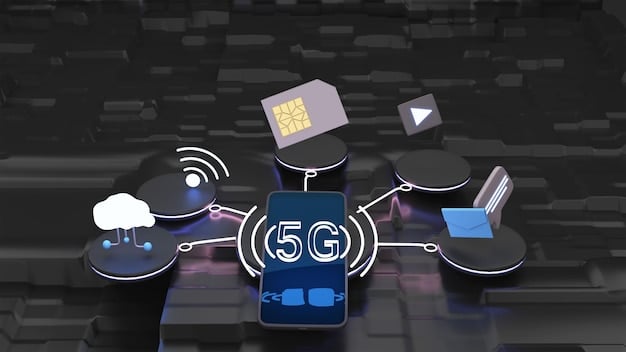Cloud Networking and 5G: Future-Proof Your US Network

Cloud networking combined with 5G offers unprecedented opportunities for US networks to achieve enhanced speed, lower latency, and greater scalability, revolutionizing industries from healthcare to manufacturing, and creating more immersive user experiences.
The convergence of cloud networking and 5G is reshaping the telecommunications landscape in the United States. Preparing your network for this future means embracing agility, scalability, and innovation. This article explores how to leverage these technologies to drive success in the US market.
Understanding the Cloud Networking and 5G Synergy
Cloud networking and 5G are two transformative technologies that, when combined, can revolutionize how networks operate in the US. Let’s delve into what makes this synergy so groundbreaking.
By understanding the individual strengths of cloud networking and 5G, and how they complement each other, businesses can unlock new possibilities for growth and innovation.

Key Benefits of Cloud Networking
Cloud networking offers numerous advantages for businesses, particularly when it comes to managing and scaling their network infrastructure. It provides flexibility, cost-effectiveness, and improved security.
Cloud-based solutions allow companies to adapt quickly to changing demands, optimize resource allocation, and reduce the burden of managing on-premises hardware.
Advantages of 5G Technology
5G represents a significant leap forward in wireless technology. It offers higher speeds, lower latency, and greater capacity compared to previous generations of mobile networks.
These enhancements enable a wide range of new applications and services, including enhanced mobile broadband, massive machine-type communications, and ultra-reliable low-latency communications.
- Enhanced Mobile Broadband: Provides faster data speeds for streaming, gaming, and other bandwidth-intensive activities.
- Massive Machine-Type Communications: Supports a large number of connected devices for IoT applications.
- Ultra-Reliable Low-Latency Communications: Enables real-time applications like autonomous vehicles and remote surgery.
In conclusion, the synergy between cloud networking and 5G offers a robust and adaptable solution for modern networks in the US, enabling businesses to innovate and stay competitive.
Assessing Your Current Network Infrastructure
Before diving into the implementation of cloud networking and 5G, it’s essential to assess the current state of your network infrastructure. This assessment helps identify strengths, weaknesses, and areas for improvement.
A thorough evaluation will provide a clear understanding of what changes are necessary to effectively integrate these advanced technologies.
Evaluating Network Performance
Start by evaluating the performance of your existing network. This includes measuring bandwidth, latency, and reliability. Understanding these metrics will highlight bottlenecks and areas that need upgrades.
Tools like network monitoring software and performance testing platforms can provide valuable insights into your network’s capabilities and limitations.
Identifying Compatibility Issues
Next, identify any compatibility issues between your current infrastructure and cloud networking or 5G technologies. Legacy systems or outdated hardware might not be able to support these advancements.
Consider whether your network can handle the increased data traffic and security requirements that come with these technologies. A gap analysis can pinpoint areas that require upgrades or replacements.
- Legacy Systems: Evaluate whether your existing systems can integrate with cloud and 5G technologies.
- Hardware Limitations: Identify any hardware that may not support the newer technologies.
- Security Protocols: Ensure that your security measures are adequate for the demands of cloud and 5G.
In summary, assessing your current network infrastructure is a critical step toward a successful transition to cloud networking and 5G, ensuring that your network is ready for these advancements.
Building a Cloud-Native Network in Preparation for 5G
Building a cloud-native network lays the essential groundwork for harnessing the full potential of 5G. This involves adopting cloud-native principles and architectures to create a more agile, scalable, and resilient infrastructure.
By shifting towards a cloud-native approach, businesses can ensure that their networks are optimized for the demands of 5G and the future.

Embracing Containerization and Microservices
Adopting containerization and microservices is a key step in building a cloud-native network. Containerization allows applications to run in isolated environments, ensuring consistency and portability. Microservices break down applications into smaller, independent services, making them easier to develop, deploy, and scale.
These technologies enable faster development cycles, improved resource utilization, and greater resilience.
Leveraging Network Function Virtualization (NFV)
Network Function Virtualization (NFV) replaces traditional hardware-based network functions with software-based virtualized functions. This allows network services to be deployed and managed more efficiently in the cloud.
NFV enables greater flexibility, agility, and cost savings by decoupling network functions from dedicated hardware.
- Increased Flexibility: Easily deploy and manage network functions on-demand.
- Improved Agility: Quickly adapt to changing network requirements.
- Cost Savings: Reduce the need for expensive hardware appliances.
In conclusion, building a cloud-native network is essential for realizing the full benefits of 5G, enabling greater agility, scalability, and efficiency.
Securing Your Cloud and 5G-Enabled Network
Securing a cloud and 5G-enabled network is paramount to protect sensitive data and ensure the reliability of critical services. The dynamic and distributed nature of these technologies requires a robust and multifaceted security approach.
Implementing comprehensive security measures can safeguard against potential threats and maintain the integrity of your network.
Implementing Zero Trust Security
Zero Trust security is a framework that assumes no user or device is inherently trustworthy, whether inside or outside the network perimeter. It requires continuous verification and authentication for every access request.
By implementing Zero Trust principles, organizations can minimize the risk of unauthorized access and data breaches.
Utilizing Advanced Threat Detection
Advanced Threat Detection (ATD) technologies use artificial intelligence and machine learning to identify and respond to sophisticated cyber threats. These tools can detect anomalies, analyze network traffic, and provide real-time alerts.
Integrating ATD systems enhances your network’s ability to detect and mitigate emerging threats effectively.
- AI-Powered Analysis: Utilize AI to identify patterns and anomalies that indicate malicious activity.
- Real-Time Monitoring: Continuously monitor network traffic for suspicious behavior.
- Automated Response: Quickly respond to detected threats with automated security measures.
In summary, securing your cloud and 5G-enabled network requires a proactive and comprehensive approach. By implementing Zero Trust security and utilizing advanced threat detection, organizations can protect their valuable assets and maintain the integrity of their network.
Optimizing User Experience with Cloud and 5G
Optimizing user experience (UX) is a critical goal when integrating cloud networking and 5G. The combination of these technologies can significantly enhance speed, responsiveness, and reliability, leading to improved customer satisfaction.
Focusing on UX ensures that users can fully leverage the capabilities of these advanced technologies for a seamless and engaging experience.
Delivering High-Quality Streaming Services
Cloud and 5G together can revolutionize streaming services. With higher bandwidth and lower latency, users can enjoy high-definition video and audio without buffering or interruptions.
Content Delivery Networks (CDNs) can be strategically deployed in the cloud to ensure that content is delivered quickly and efficiently to users around the globe.
Enhancing Mobile Gaming Experiences
The combination of cloud and 5G can transform mobile gaming experiences. Low latency ensures real-time responsiveness, while high bandwidth allows for richer graphics and immersive gameplay.
Cloud gaming platforms can leverage the power of cloud computing to offload processing tasks, allowing users to play demanding games on less powerful devices.
- Low Latency: Ensure real-time responsiveness for competitive gaming.
- High Bandwidth: Deliver richer graphics and immersive gameplay.
- Cloud Processing: Offload processing tasks to the cloud for improved performance.
In conclusion, optimizing user experience is a key objective when integrating cloud networking and 5G. By focusing on delivering high-quality streaming services and enhancing mobile gaming experiences, businesses can provide users with a seamless and engaging experience.
Future Trends in Cloud Networking and 5G for US Networks
The future of cloud networking and 5G in the US is bright, with several trends poised to shape the industry. Staying informed about these trends is crucial for businesses looking to remain competitive and innovative.
By understanding the evolving landscape, organizations can make strategic decisions and investments to drive growth and success.
The Rise of Edge Computing
Edge computing brings computation and data storage closer to the edge of the network, reducing latency and improving performance for real-time applications. This trend is particularly relevant for 5G networks, which require low latency to support applications like autonomous vehicles and industrial automation.
Deploying edge computing infrastructure can significantly enhance the capabilities of cloud and 5G networks.
Integration of AI and Machine Learning
Artificial Intelligence (AI) and Machine Learning (ML) are increasingly being integrated into cloud networking and 5G solutions to automate network management, optimize performance, and enhance security. AI-powered tools can analyze network data, predict potential issues, and automatically adjust network parameters to ensure optimal performance.
By leveraging AI and ML, organizations can improve the efficiency and reliability of their networks.
- Automated Management: Automate routine network tasks to reduce operational costs.
- Performance Optimization: Optimize network parameters for peak performance.
- Enhanced Security: Detect and respond to threats more effectively.
In summary, the future of cloud networking and 5G in US networks is characterized by the rise of edge computing and the integration of AI and machine learning. By embracing these trends, businesses can position themselves for success in the evolving landscape.
| Key Point | Brief Description |
|---|---|
| 🚀 Cloud Networking Benefits | Offers flexibility, cost-effectiveness, and security for managing network infrastructure. |
| 📶 Advantages of 5G | Provides higher speeds, lower latency, and greater capacity for wireless communication. |
| 🛡️ Securing Networks | Implementing Zero Trust and advanced threat detection is crucial for network security. |
| 💡 Future Trends | Edge computing and AI integration are key trends shaping the future of networks. |
[Frequently Asked Questions]
▼
Cloud networking refers to the use of cloud computing technologies to manage and deliver network resources and services. It offers flexibility, scalability, and cost-effectiveness compared to traditional networking models.
▼
5G offers higher speeds, lower latency, and greater capacity compared to previous generations of mobile networks. It enables new applications and services, such as enhanced mobile broadband and massive machine-type communications.
▼
Securing a cloud and 5G-enabled network requires a robust and multifaceted approach. Implementing Zero Trust security principles and utilizing advanced threat detection tools are essential steps.
▼
Edge computing brings computation and data storage closer to the edge of the network, reducing latency and improving performance for real-time applications. It is particularly important for 5G networks.
▼
AI and machine learning can automate network management, optimize performance, and enhance security. AI-powered tools can analyze network data and predict potential issues to ensure optimal performance and reliability.
Conclusion
Preparing your US network for the future requires embracing the synergy of cloud networking and 5G. By assessing your current infrastructure, building a cloud-native network, securing your network, optimizing user experience, and staying informed about future trends, you can unlock the full potential of these transformative technologies.





